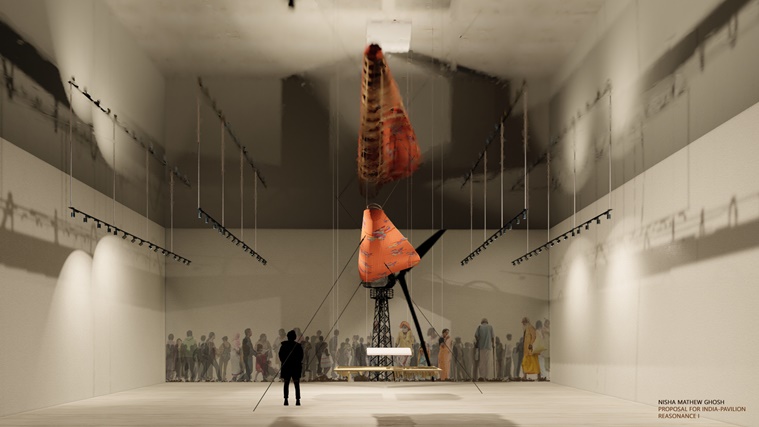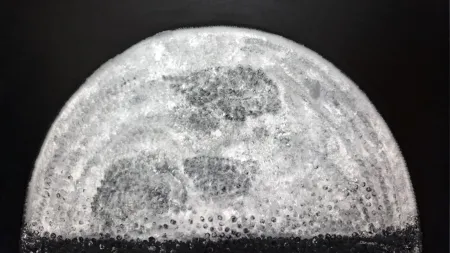- India
- International
‘Small is necessary as it can build a future of a clean and green India’
Architect Nisha Mathew Ghosh, who will curate the India Pavilion of the London Design Biennale 2021, shares her preliminary thoughts on green ideas that will make up a billion stories
 Curator of the Indian Pavilion at the Biennale, architect-researcher Nisha Mathew Ghosh. (Credit: Mathew and Ghosh Architects)
Curator of the Indian Pavilion at the Biennale, architect-researcher Nisha Mathew Ghosh. (Credit: Mathew and Ghosh Architects)
The Indo-China conflict of 1962 led to the famous Chipko movement, making women the warriors to save the Himalayan landscape. Nearly two decades later, in Bengaluru, water activist S Vishwanath found well-digger Muniappa along a mud path. Muniappa had dug nearly 3000 wells across the state. More recently, in Kerala, two brothers have invented a low-cost wind turbine, as small as a ceiling fan, that can power an entire house. In Ahmedabad, two innovators are using a drip irrigation method to cure concrete, which otherwise has been energy and water-intensive. These are among the many stories that will be showcased at the India Pavilion of the London Design Biennale 2021 in June. It’s a response to the event’s Artistic Director Es Devlin’s question: How can design provide solutions to the major crises of our time?
The curator of the Indian Pavilion at the Biennale, architect-researcher Nisha Mathew Ghosh, co-founder of Bengaluru-based Mathew and Ghosh Architects, talks about why these individual stories have a mass impact, how they hold the keys to an ecologically resilient India and why it benefits the next generation. Excerpts:
You have themed the India Pavilion on ‘Small is Beautiful: A Billion Stories’. Why and how does it reflect the overall theme?
It hinges on the anticipation that the very many ‘small’ ideas and investigations that we make towards building ecological resilience across disciplines, can have a collaborative resonance. It implies that small is necessary. These stories can build a future of a clean and green collaborative India.
What kind of research was done in the selection of grassroots stories?

The work is ongoing, and we will shortly have a call for the entries published via social media and magazines. The stories range from manufacturing to architecture, textiles to brownfields, cosmetics to peoples grassroots movements such as Chipko and so on. We will have a second team of researchers who will map each of these stories to create a body of work and make it available as academic material.
What are these stories and how do they illustrate ecological solutions?
The mapping and documentation of these stories under categories of Water, Air, Forest, Energy and Earth/Brownfield represent ideas across knowledge domains that have been developed by thinker-dreamers, communities, entrepreneurs and companies committed to a better future.
Not all ‘small’ solutions can be scaled up, are you also promoting the idea of the local?
Local is a big part of being sustainable, however, there are aspects of capitalist global trade that are here to stay, and we have to work around its advantages and our common learnings. Having said that, this exhibition maps local ideas and solutions. Some are scalable, others may need further work, but we are seeking to present this body of collective knowledge and our ecology heroes, which must then build on itself and build outwards to reach critical mass.
 India Pavilion installation. (Credit: Mathew and Ghosh Architects)
India Pavilion installation. (Credit: Mathew and Ghosh Architects)
From the Chipko movement to restoring water tables in Bangalore, there are multiple examples of how the forest, air, earth and water have been replenished. Where do you think our challenges lie?
There are a lot of committed practitioners and a lot of work has been done. The work has to build scale and traction to become the norm rather than the exception because, at the scale of impact, it still seems like a lonely beacon. The exhibition will highlight the work of these practitioners, the pioneers so to speak, hoping that migrators and settlers will also one day soon occupy the landscape at which point systemic change is possible.
How have you envisioned the layout and design of the pavilion?
There will be an art-craft installation made in bamboo and sustainable textile. I’m collaborating with Soumitro Ghosh, Sandeep Sangaru Design for bamboo, and Maker Studio Eleatz for sustainable textile work. The content will be presented via book displays and a film. These elements are part of the exhibition at the space assigned to us at Somerset House in London.
Apr 16: Latest News
- 01
- 02
- 03
- 04
- 05


































